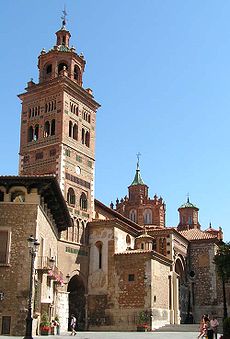Bishop of Teruel
|
Diocese of Teruel and Albarracín Dioecesis Terulensis et Albarracinensis Diócesis de Teruel y Albarracín |
|
|---|---|

|
|
| Location | |
| Country | Spain |
| Ecclesiastical province | Zaragoza |
| Metropolitan | Zaragoza |
| Statistics | |
| Area | 11,867 km2 (4,582 sq mi) |
| Population - Total - Catholics |
(as of 2010) 93,600 89,750 (95.9%) |
| Information | |
| Denomination | Roman Catholic |
| Sui iuris church | Latin Church |
| Rite | Roman Rite |
| Established | 31 July 1577 (As Diocese of Teruel) 7 September 1851 (As Diocese of Teruel-Albarracín) 11 August 1984 (As Diocese of Teruel y Albarracín) |
| Cathedral |
Cathedral of St Peter in Teruel Cathedral of Our Lady and St James in Albarracín |
| Current leadership | |
| Pope | Francis |
| Bishop | Carlos Manuel Escribano Subías |
| Metropolitan Archbishop | Vicente Jiménez Zamora |
| Website | |
| Website of the Diocese | |
The Diocese of Teruel and Albarracín (Latin, Turolensis, Albarracinensis) is a Roman Catholic ecclesiastical territory located in north-eastern Spain, in the province of Teruel, part of the autonomous community of Aragón. The diocese forms part of the ecclesiastical province of Zaragoza, and is thus suffragan to the Archdiocese of Zaragoza.
In 1912 the diocese of Teruel comprised the civil province of the same name, excepting the town of Bechi (Castellón).
All the churches of Teruel are contemporary with its foundation (1176), as the founders built nine churches, one, Santa Maria de Mediavilla, in the centre, and the remaining eight in a circle following the circuit of the walls. The central church was made a collegiate church in 1423 and named the cathedral in 1577. It was originally built of brick and rubblework, but since the restoration in the seventeenth century it has lost its primitive character. The Doric choir stalls were the gift of Martín Terrer de Valenzuela, Bishop of Teruel, and later of Tarazona.
It is believed by some that Teruel and the ancient Turba are the same. Turba was the city whose disputes with the Saguntines gave Hannibal an excuse for attacking Saguntum and beginning the Second Punic War. According to the annals of Teruel it appears that Turba was not situated on the site of the present city of Teruel, but at its boundary line.
...
Wikipedia
